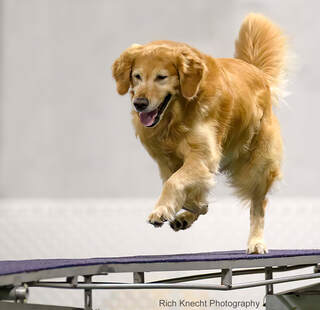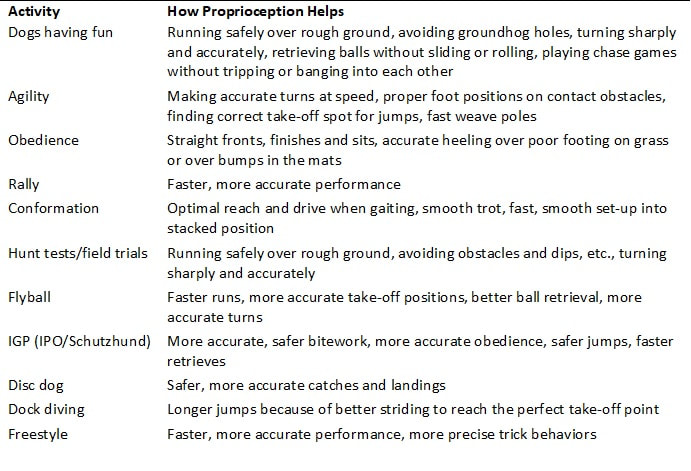
Proprioception is how a baseball player hits a 3” ball going 95 mph with a 2 ¾” bat. It’s how your agility dog flies over the dog walk placing its feet in exactly the right spots on a narrow board. Check out the dog in the image above – his right rear foot has about one inch to spare! It’s how your athletic dog snags a thrown ball in mid-air and lands running. It’s responsible for your dog’s paw-eye and mouth-eye coordination. A well-tuned proprioceptive system will prevent your dog from making one or many missteps that could lead to a catastrophic injury.
Proprioception is so important that EVERY living thing has a proprioceptive system – mammals, birds, reptiles, and even insects. In fact, even plants have proprioception – it is how flowers know whether they are open or closed and whether they are leaning towards the sun for optimal energy production.
Your dog’s proprioceptive system is like a body-wide GPS system. Just as your cell phone can tell others where you are on the map, there are billions of sensors throughout your dog’s body that constantly deliver neurological messages to your dog’s brain. These sensors, also called proprioceptors, are present in the skin, muscles, tendons, and in tissues around the joints.
As your dog moves, it must continuously monitor its posture and adjust muscle activity as needed to provide balance. Proprioceptors sense these movements and allow fast, unconscious, and accurate execution of these behaviors. They send messages along specialized nerve tracts that contain information about the exact positions of the limbs, head, and the rest of the body, as well as how fast and in what direction those body parts are moving, and how much load they are bearing, so that instantaneous corrections can be made. If your dog’s estimate of their limb’s initial position is wrong, proprioception is crucial in correcting the movement. So, if your dashing dog makes an error in foot placement, the proprioception system instantaneously tries to correct it. You can see why this system is so important in injury prevention!
The neurological systems of mammals like dogs have several distinct components that have separate nerves and pathways in the spinal cord along which messages travel to and from the brain. Most of us are familiar with the sensory and motor components, which control the senses, like sight and hearing, and movement. But did you know, proprioception is the third component of the nervous system, also with its own nerves and pathways in the spinal cord? That’s how important it is!
At 3 weeks of age, as puppies are beginning to walk around and explore their world, they have more neurons than they will ever have. As they experience life in those first weeks and months, neurons that are useful are retained and those that remain unused are pruned and die off. For the proprioceptive neurological system to develop optimally, young puppies need to experience a lot of environmental stimuli. They need to move at varying speeds over different types of terrain and explore as many new objects as possible. That will help them retain all of those important proprioceptors, nerves, and spinal tracts.
It takes many months for a puppy’s proprioceptive system to develop optimally. Remember how, as a fast-growing teenager, you kept bumping into things or were embarrassingly clumsy? Well, the same is true for puppies as they grow. Sometimes the front legs are suddenly longer than they should be, then the rear legs or the body might grow and change the dog’s proportions and balance. All this time, the proprioceptive system is scrambling to keep track of all these changes. But ultimately, around 1 to 1 ½ years of age, everything settles in and your dog actually knows what it’s doing with its body, thanks to proprioception. This is one of the reasons why many people recommend delaying really intensive physical training to reduce the risk of injuries until the body is mature.
The following table lists examples of canine activities that get a major assist from proprioception:

Losing It
Unfortunately, “use it or lose it” seems to be the motto of the neurological system. As a result, it is important to participate in activities and exercises throughout our dogs’ lives to keep that proprioceptive system tuned up. More on that below.
Despite our best intentions, however, there are times when the proprioception system can go into decline. Here are some examples:
Exercises to Hone Proprioception
All types of exercise give the proprioceptive system a workout. However, specific exercises can be used to really polish and strengthen those pathways. Here are some:
Interestingly, chiropractic is specifically designed to hone proprioception, so getting regular adjustments should be a part of every active dog’s maintenance routine.
Just Do It!
Hopefully you realize the importance of the proprioceptive system for improving your dog’s ability to experience a full and active life while reducing the likelihood of musculoskeletal injury, or at least reducing the severity of an injury should one happen. Surprisingly, few people add proprioceptive exercises to their dogs’ fitness regimens. That might be because these exercises seem…well…too simple. They don’t get the dog panting or tire them out, so sometimes people believe that they aren’t that important. But in fact, unseen neurological changes are taking place when your dog executes these exercises.
Keeping your dog’s proprioceptive system honed might be the most important thing you can do to reduce the risk of injuries, with all of their associated costs, downtime, and heartache. In addition, the scientific evidence suggests that proprioceptive exercises are one of the best ways to increase your dog’s health span – the length of time your dog is healthy and active – and who doesn’t want that? So just do it – only 10 minutes twice a week and you’re good to go!
Reference
1. Cadore EL, Rodríguez-Mañas L, Sinclair A, Izquierdo M. Effects of different exercise interventions on risk of falls, gait ability, and balance in physically frail older adults: A systematic review. Rejuvenation Res 2013;16(2):105-114.